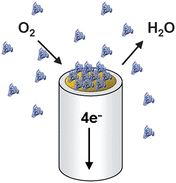Oxygen is a major actor of many physiological, biological and industrial processes; as such, its monitoring is of paramount importance. The effects of protein biofouling on dissolved oxygen measurements are described. The consequences of protein adsorption on electrode kinetics and mass transport were quantified using cyclic voltammetry, AC impedance and rotating disc amperometry, firstly in a solution of albumin, secondly in a complex protein suspension of liver tissue. The effect of membrane coatings poly(styrene-sulfonate)/poly(L-lysine) and fibronectin were investigated. The relative significance on mass transport, surface diffusion and electrocatalysis were examined by comparing the experimental data for an outer-sphere redox couple, ruthenium hexaammine (III)/(II), with the physiologically significant electrocatalytic O2reduction reaction.
You have access to this article
 Please wait while we load your content...
Something went wrong. Try again?
Please wait while we load your content...
Something went wrong. Try again?


 Please wait while we load your content...
Please wait while we load your content...